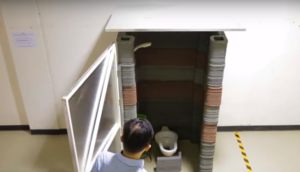AM.NUS’ New Construction 3D Printing Programme Starts Out in the Toilet
 3D printing has enabled the construction industry to lower costs and ramp up production speeds, along with using better building materials and designs to make improved, eco-friendly structures.
3D printing has enabled the construction industry to lower costs and ramp up production speeds, along with using better building materials and designs to make improved, eco-friendly structures.
The Centre for Additive Manufacturing (AM.NUS) at the National University of Singapore (NUS) is joining the 3D printed construction party with the launch of its Construction 3D Printing Programme, supported by the National Additive Manufacturing Innovation Cluster (NAMIC) and based out of the university’s School of Design and Environment (SDE).
The program, in an effort to increase the adoption of construction 3D printing and show its value, will work to set up an ecosystem for the technology in Singapore through industry collaborations and research. AM.NUS’ new program will facilitate the mass production of 3D printed structures by developing novel, sustainable materials and designs, and will also encourage knowledge sharing by organizing events like workshops and conferences and providing training to industry partners and university students.
A construction 3D printing laboratory was also established under the program, both of which were launched at the International Conference on Construction 3D printing held at NUS earlier this week; the SDE also signed a Memorandum of Understanding (MOU) with a local construction firm, Yosen Advanced Digital Construction and Manufacturing Pte Ltd, at the conference. The laboratory will be home to Singapore’s largest gantry style concrete 3D printer, which will be used to test out the program’s new designs and materials. The goal is to create 3D printable concrete structures that can quickly and easily be mass produced in a sustainable manner.
If construction 3D printing succeeds in widespread adoption, countries around the world will be able to better meet the ever-growing demands for rapid building of houses and even sanitation facilities. Researchers with the laboratory and the new AM.NUS Construction 3D Printing Program will be working closely with industry partners on multiple research projects, two of which have already begun.
The first project, which is happening in collaboration with Hamilton Labs and NAMIC, is focused on increasing the production of 3D printed toilet units in order to improve sanitation in India, which is in dire straits at the moment. Over 300,000 deaths in the country every year are caused by diarrheal diseases due to open defecation in ponds, lakes, and rivers where people access water. The country’s government has vowed to put an end to open defecation by 2019, but building toilets there is still ineffective, due to the manual labor required.
AM.NUS researchers conducted field studies in different parts of India in order to develop a novel design for a toilet unit that addresses some of the major challenges of building a toilet in the country, such as installation, construction, and transportation.
The design created by the AM.NUS Construction 3D Printing Programme can be 3D printed in less than five hours; typical toilets currently each take an entire day to build. In addition, 3D printing this new toilet saves 25% of the usual cost, and it’s made up of 12 small modules which can be easily transported to its ultimate destination for assembly and installation; researchers are also investigating the addition of recycled materials to the concrete used to build the toilets. The toilet unit will be shipped to India in the future for installation.
The program’s second research project also centers around toilets, as researchers work to develop the first 3D printed volumetric formwork for bathroom units.
According to NUS, “There is much untapped potential in the use of 3D printing to shape the future of construction. Setting up the AM.NUS Construction 3D Printing Programme is a strategic push to promote widespread adoption of 3D printing technology in construction. By coupling the latest 3D printing technology know-how with the suite of research capabilities in building materials and design at NUS, the new unit could contribute towards making construction more efficient and sustainable.”
While traditional formworks for concrete constructions are made using timer or steel, the new formwork replaces these materials with a polymer. It can also take nearly an entire day to finish constructing the formwork for a typical HDB bathroom unit, but 3D printing and a semi-automated production line will allow for the completion of up to 24 units a day. The program’s researchers are currently working with a local firm and the local authorities to advance this second project.
Discuss this story and other 3D printing topics at 3DPrintBoard.com or share your thoughts in the Facebook comments below.
Subscribe to Our Email Newsletter
Stay up-to-date on all the latest news from the 3D printing industry and receive information and offers from third party vendors.
Print Services
You May Also Like
3D Printing Grows to $15.9B in 2024 Amid Shifting Industry Dynamics
The global additive manufacturing (AM) market reached $15.9 billion in calendar year 2024, according to “Q4 2024 3DP/AM Market Data and Forecast” from Additive Manufacturing Research (AM Research). Despite a...
Low-cost “Suzy” Polymer Powder 3D Printer is Faster and Cheaper than Past Models
Polish laser powder bed fusion (LPBF) firm Sinterit has released a follow-up to its predecessors, Lisa and Nils, called Suzy, a $19,490 printer equipped with a 30W fiber diode laser....
BellaSeno’s 3D Printed Breast Implants Keep Shape with 87% Fat Volume, Avoids Silicone Risks
At a medical conference in Austin this week, a new kind of breast implant took center stage. It is not made from silicone but from a 3D printed, fully resorbable...
Australia’s Untapped Potential as a Disruptive Innovator: SPEE3D CTO Steven Camilleri Explains Why He Wants to Make Stuff There
When I first met Steven Camilleri in 2023, the CTO of additive manufacturing (AM) OEM SPEE3D shared a quote with me from Clayton Christensen, the late Harvard professor who popularized...





























